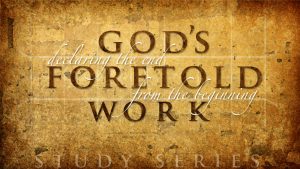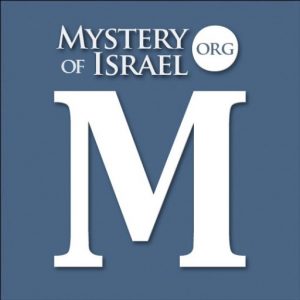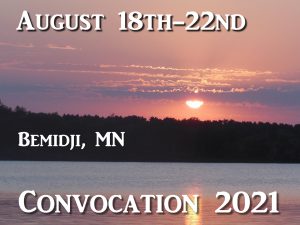Thank you (and thank God!) for the piece I just re-read on “The Mystery of the Gospel”. The matter of the gem and its setting explains so succinctly the transition that my wife and I have undergone, as I have tried to express before, in this regard. But, once the gem is appreciated in its chosen setting, can it ever seem right to separate what God has joined? We’ve been looking at the relatedness of Rom 16:25 and Rom 11:25 over here and considering other NT passages containing mysterion ((the Greek word translated Mystery is used 27 times in the NT and means that which, being outside the unassisted natural apprehension, can be made known only by divine revelation.)), including Ephesians. In regards to Romans, it is hard to miss the pride of place given to this theme, being effectively highlighted in the crescendo to the Rom 11 doxology and Rom 16 benediction; the language of the latter leads me to question whether the church can ever really be “established” in the absence of the appreciation of the “mystery kept hidden, but now revealed”. I’d like to try and write something down about this.
Kind regards in the Lord
CN
Thanks for sharing your appreciation. I see from your remarks that you are making some insightful connections, and I think, definitely the right ones. I believe it is important to show the evidence without overly directing conclusions (Jn 6:45; 1Jn 2:27).
This theme of mystery, and “the God who hides Himself” (Isa 45:15) is rarely considered. You rightly detect its central importance in the apostolic understanding of the gospel, as a revealed secret, aimed to trap and expose the principalities and powers, and to judge pride. At the same time, it reveals the ‘hidden wisdom ordained to the believer’s glory” (1Cor 2:7-8). Yet, this hidden plan of God was fully laid out in the OT Scriptures (Acts 3:18-21; Ro 16:25-26; 1Pet 1:11). According to Paul, it was not foretold in the part, but in the whole (Acts 26:22). However, it was foretold in such a way, that its full unveiling would be guarded until the time appointed.
This is truly amazing. It is awesome to consider how this mystery could be so perfectly and fully foretold in the prophetic writings (Acts 26:22; Ro 16:25-26) in such a way as to remain hidden from the demonic powers (1Cor 1:8), even as it presented an insoluble puzzle, not only to John the Baptist and the disciples (Mt 16:22; Lk 17:19; 18:34; Acts 8:34), but no less to the very prophets to whom the scripture was first revealed (1Pet 1:11-12).
The mystery of Christ and the gospel (Eph 3:4; 6:19; Col 4:3) became the new watershed of division in Israel. It has remained the ultimate and insurmountable point of division between church and synagogue. Though once hidden beyond human or angelic ability to discern, the revelation of the gospel can be shown to be “none other things than those which the prophets and Moses did say should come” (Acts 26:22). This is a marvelous phenomenon, which proves, beyond reasonable dispute, that the gospel reveals a secret that was fully foretold in the prophetic scriptures of the OT, which can be fully demonstrated (Ro 16:26).
Paul is careful to distinguish his gospel as “according to the revelation of the mystery kept secret since the world began, but now made manifest.” It is to be made known to all nations by means of the prophetic writings, thus effecting the obedience that is of faith (Ro 16:25-26). All of this, says Paul, is “according to the commandment of the everlasting God.” This is how the earliest disciples presented the basic proclamation of the gospel, as seen all throughout the book of Acts. The powerful evidence of prophecy, confirmed by the mighty acts of the Spirit in the church, removed the cloak that would leave Israel without excuse, and ripe for judgment.
This brings us to ask, if Israel was confronted by such a well hidden mystery, will the nations escape the same deep searching? Will the church escape? If the mystery was ordained to bring judgment on the pride of Israel, what will it mean for the nations? More particularly, what will it mean for a professing church that has perennially boasted against the branches on its way to a final “great falling away”?
It is my studied conviction that the same prophetic mystery will have a yet future working in the days leading into the final tribulation. Once more, it will confront not only Israel, but the nations and the church in the nations in the form of “the controversy of Zion” (Isa 34:8; Zech 12:2-3; Hab 1:5). Then will the hiding place be uncovered, not only for Israel, but for all nations and for the church of the great apostasy. It is the same rock of offense that should have been “for a sanctuary” (Isa 8:14-17). “This is the rest and the refreshing that Israel will once again dismiss as foolish and unworthy of consideration (Isa 28:12-17). But when the overflowing scourge of the invading armies of Antichrist will come in like a flood, this vision will speak to Israel throughout the time of Jacob’s trouble until the day of their repentance. “In the latter days, you will consider it” (compare Deut 4:30, 39 with Jer 23:20; 30:24).
The mystery is simply the gospel, but as this section of scripture shows, it takes the form of a “line upon line, here a little, there a little” message in the time of the final Antichrist, of which the Assyrian was only a type. We should take note that this end time testimony is voiced to Israel by gentiles (stammering lips and another tongue was idiomatic for gentiles; see Deut 28:49; Isa 33:19). Perhaps this is part of the reason it is so confidently dismissed. Notice also that Isaiah describes this prophetic testimony of warning by language that the NT writers will later use to distinguish the milk of the Word from the meat of the Word (compare, Isa 28:9; Mt 24:45; with Heb 5:12; 1Pet 2:2).
Although the secret is now open and capable of clear doctrinal formulation, its inward character can only be savingly apprehended by the quickening of the Spirit. Even now, the line of division in the professing church is not mere consent to the creed, however accurate, but whether Christ has been revealed to the heart by the Spirit. The latter produces saving faith, whereas the former produces a dangerous false security that will be manifest in the great falling away.
When Jesus said, “Upon this Rock I will build my church,” I don’t believe he was speaking only of Peter’s confession, but the grace of “revelation” which cannot come by flesh and blood. It is the “revelation” of Christ by the Spirit that separates between the living and the dead. It is possible to have a correct creed and an unchanged heart, but it is not possible to behold His glory by the revelation of the Spirit and remained unchanged (2Cor 3:18). Here is an important principle. “When He shall appear, we shall be like Him, because we shall see Him as He is” (1Jn 3:2). The seeing that will be perfect and complete in that day is also the issue of present transformation.
True spiritual change is a matter of revelation. It is more than the issue of accurate information, as in all the works religions; it is the living apprehension of the truth by the Spirit of truth. Jesus said to the Pharisees, “You have never heard His voice at any time, nor seen His form” (Jn 5:37). To see is to live. “And this is the will of Him who sent Me, that everyone who sees the Son and believes in Him may have everlasting life …” (Jn 6:40). His image is formed in us, as we “see Him as He is.” Since “it is the Spirit who makes alive; the flesh profits nothing” (Jn 6:63), we may be sure that it is only the Spirit quickened Word that can divide between soul and spirit (Heb 4:12). This is the seeing and the hearing that regenerates.
The prophets foretold that Israel would stumble at the sealed vision (Isa 8:14-15; 16-17; 28:9, 12-13, 16; 29:10-11, 14; Dan 9:24; 12:4). Only in hindsight could it be seen that this would come about by the rejection of the Messiah (Isa 49:7; 50:6; 53:3-4; Mic 5:1, 2; Dan 9:26). Until the fulfillment, who would have thought that Israel’s fall would come through a mystery that was fully foretold in the writings of the prophets, albeit in such a way as to elude both men and angels until after it had been fulfilled? (Mk 8:30; 9:9; 1Cor 2:8). Who would have thought that the blessing of the nations would come, not through Israel’s post-tribulational exaltation, as commonly expected, but through Israel’s fall, as completely unexpected?
Who could have considered that the Messiah would appear to bring in the promised “everlasting righteousness” (Jer 32:40 with Dan 9:24) by His atoning death (Isa 53:8; Dan 9:26), and that He should rise and ascend in the midst of history? Even if such an one as John the Baptist might advanced so far as to see that Messiah was to suffer (“Behold the Lamb of God, who takes away the sin of the world”), who could have imagined that Messiah would rise and ascend in the midst of history before the great transition of Zion’s travail and the Day of the Lord (Isa 13:7-8; 66:7-8; Mic 5:3 with Jer 30:6-7; Rev 12:2-6)? This was a mystery of the first magnitude.
Jesus was the lone custodian of the secret (Isa 53:11). Until the appointed time of revelation, the ‘mystery of the gospel’ (Eph 6:19) was kept as a divinely guarded secret (Ro 16:25), concealed from both men and angels (Isa 8:16; 53:1; Mk 4:11; 8:30; 9:9 with 1Cor 2:8). But where was the mystery concealed? It was concealed in the prophetic scriptures of the Hebrew Bible (Acts 3:18-21; 26:22; Ro 16:25-26; 1Pet 1:11). That is why that after the mystery was revealed by the Spirit at Pentecost (compare Jn 16:13; 1Cor 2:10; Eph 3:5; 1Pet 1:12), the prophetic scriptures of the OT would become the greatest evidence that God had determined, from the beginning, to turn the worst of evils into the greatest possible good, but at the greatest conceivable cost. Staggering thought! What can be more humbling, than to apprehend in some measure the unspeakable cost of our salvation?
What wisdom! What precise symmetry of foretold prophetic unfolding! What beauty and glory beyond description! Yet, at what an awful and imponderable divine cost. The ruler from Bethlehem will be abhorred and smitten (Isa 49:7; 53:3; Mic 5:1-2). “An anointed prince” (literal Hebrew) shall be “cut off” (Isa 53:8; Dan 9:26). Because they will smite the Davidic ruler from Bethlehem “with a rod upon the cheek” (idiom for the Messiah’s death at the hands of His brethren), King Messiah’s brethren (the Jews) would be “given up”. Not forever, but only until the time when she who travails has brought forth” (compare Mic 5:3 with Isa 13:8; 66:8; Jer 30:6-7; Dan 12:1; Mt 24:15; Rev 12:2, 6).
During this unknown ‘time between the times’, God would be hiding his face from the larger nation (Deut 31:17-18; 32:20; Isa 8:17; Ezek 39:29), while a “not a people” is grafted in to provoke Israel to jealousy (Deut 32:20-21; Ro 10:19; 11:11). At last, in the latter days, in the time of greatest affliction, the temporarily deserted nation (I will return to my place”; Hos 5:15 with Mt 23:39) makes penitent acknowledgement of some consummate “offense” (singular, not plural; Hos 5:15 with Mic 5:1; Isa 53:3, 8; Dan 9:26). With this, they are raised to live in His sight the full balance of the third day. Notice the amazing parallel of pattern between the trajectory of the nation and the life of Jesus. Like the nation, Jesus comes up out of Egypt and into the wilderness to be finally raised out of death to exalted glory. This is just part of “the fellowship of the mystery” (Eph 3:9), which God ordained before the world unto our glory” (1Cor 2:7).
In one stroke, the same mystery that brings in the “everlasting righteousness” (Jer 32:40; Dan 9:24-26), sets a trap that defeats the powers, by turning their wisdom upon them, to their utter destruction (Isa 8:14-15; 28:13 with 1Cor 2:8). Christ’s crucifixion signifies the public exposure of the wisdom of the principalities and powers of this age, which lose their power when the flesh loses its power. We might say that the power of the powers is broken when the power of the flesh is broken. Significantly, their power is ended when man (‘Jacob’) comes to an end of his power (Deut 32:36; Dan 12:7). That’s why brokenness in the Christian life is such a sign that the powers have lost their sway with an individual. It is the same with the corporate life of the body, and it will be the same with the servant nation, Israel, in the coming millennium.
In NT perspective, revelation of mystery is a strategy of divine warfare that casts down, or takes captive, the false rulers of this age (2Cor 10:5; Eph 4:8; 6:12; Col 2:15; Rev 12:10). The powers know that they have been defeated, but their sway over the nations continues until the mystery of God is finished at the end of the great tribulation (Rev 10:7; 12:12; 20:2-4).
At Christ’s return, Satan is bound, but only until there is a further divine purpose for his momentary release at the end of the thousand years (Rev 20:2-3, 7-8). This shows that no power, might, or dominion can exist that is not fitted into the service of the greater glory of God’s eternal purpose in Christ (Ps 76:10; Jn 19:11; Ro 9:17). “For by Him were all things created, that are in heaven, and that are in earth, visible and invisible, whether they be thrones, or dominions, or principalities, or powers: all things were created by Him, and for Him” (Col 1:16; Rev 4:11).
The content of the mystery is not confined to Christ’s first advent. It reaches to the second coming (Rev 10:7). It includes the events that lead up to the post-tribulational deliverance of Israel (Isa 28-29 etc.). In its final stage, it will take the form of ‘the controversy of Zion’ (Isa 34:8) that is ordained to sweep all nations into its irresistible vortex (Zech 12:2-3).
Though once and for all revealed by the Spirit sent down from heaven (Jn 16:13; 1Pet 1:12), the mystery still has its working as a two edged sword for both judgment and the revelation of glory and grace. It remains a stone of stumbling and rock of offense (Isa 8:14-15; 28:16; Ro 9:31). The same mystery that made Jesus such an offense to Israel, will crowd all nations into another great crisis of decision.
The last day’s form of this mystery will evoke all the great issues of the faith. Scripture is clear that it will come as a cup to the nations in the form of the Jerusalem question (“the holy covenant”; see Dan 11:28, 30). Through the crisis of Jerusalem all the great issues of divine contention will become ultimately intense, as the world is drawn inexorably into the unequaled time of tribulation, called, “the time of Jacob’s trouble” (Jer 30:7 with Dan 12:1; Mt 24:21).
This is necessary to “finish the transgression” (Dan 8:13; 9:24) in the final treading down of Jerusalem (Isa 63:18; Rev 11:2). The mystery of iniquity must be revealed in a final war against the covenant before Christ can return to finish the mystery of God (2Thes 2:3, 7-8; Rev 10:7) in the resurrection of the saints and in the deliverance of Israel (Isa 59:19-21 with Dan 12:1-2; Ro 11:26). Clearly, the mystery is not limited to the person and work of Jesus, but comprehends both comings. It is the mystery of Christ’s coming, departure, and return “to Israel,” with the emphasis on Israel.
Recently, I went over much of this with the teenage son of a close friend. He was able to grasp very well all the basic parts. I drew the basic outline out on a table napkin. I showed him the mystery of the Christ two comings to Israel in Mic 5:1-5 with Hos 5:15 – 6:2; Zech 12:10 with Mt 23:39; and Dan 9:26 with Isa 53:8. He could see the clear analogy with Joseph, as a type of Christ’s self revelation to his brethren by comparing Mic 5:3-4 with Hos 5:15, and Mt 23:39 in light of Zech 12:10.
By comparing Hos 5:15-6:2 with Mic 5:3, he was able to see that the nation was “given up” for their smiting of the ruler from Bethlehem with a ‘rod upon the cheek’ in Mic 5:1. With this, God returns to His place (Hos 5:15) and there abides “until” they acknowledge their offense (not “offenses” plural, but “offense” singular). This happens at a time of great affliction (“until the time when she which travails has brought forth”). I explained that this language matches the many references in the prophets to a final travail or tribulation for Israel, which Jeremiah called, “the time of Jacob’s trouble,” a time like no other (Jer 30:6-7), which both Daniel and Jesus refers to as the unequaled tribulation; Dan 12:1; Mt 24:21, and John as, “the tribulation, the great one,” Rev 7:14).
Then, we looked at the two days of Hos 6:2. I suggested that this is the time span between the nation’s great transgression and the deliverance that comes at the end of Jacob’s trouble. Scholars say that Christ rose on the morning of the third day. In like analogy, after two days (two thousand years), the nation of the dry bones is “revived” by the Spirit of grace (Isa 66:8; Ezek 39:22, 29; Zech 12:10) to live out the third day (the thousand year reign of Christ) “in His sight”, as a living, all righteous nation, none saying to his neighbor, “know the Lord” (Jer 31:34).
According to Hos 5:15, the one who came to His own would depart and return to His place, “until,” in a time of great affliction (Jacob’s trouble), the nation would make penitent acknowledgement of its “offense” (not just guilt in general, but a particular great transgression; see Mt 23:39 with Zech 12:10; Rev 1:7). The young fellow, along with his dad, were both amazed at God had foretold all things in a mystery.
Who can deny that this is no contrivance, or reading into the text? It is a mystery, built right into the prophecies, to be seen in hindsight, to the profound confirmation of the truth of the gospel. We knew we were looking at a divine masterpiece! No wonder Paul wanted all men to see the fellowship of this mystery. It’s the glory of the gospel! Nothing less or other.
We then looked at the many places where this gap appears between the advents (see Deut 32:20-21 with Isa 8:16-17 with Ezek 39:29 and Ro 10:19-20; 11:11, 25), marking all the glorious ‘until’s’ of prophecy. We saw in 1Pet 1:11-12 how the prophets, who received the initial revelation of the scriptures, were aware that they were ministering these things to us, who would receive the fuller understanding of these things by the Holy Spirit sent down from heaven (1Pet 1:12).
This is why Jesus did not explain the mystery before the time, but constantly commanded silence until after His passion would be accomplished at Jerusalem. By His knowledge the Servant would justify the many (Isa 53:11). But notice, that He left it all to the Spirit to reveal, just as He promised (Jn 16:13). He was the lone guardian of the secret, as in the song by Michael W. Smith, “nobody knew His secret intention was to give His life away.” What a glory to see Jesus in complete command of the messianic secret, dropping hints and clues all along the way that would make it clear in hindsight, that He knew all things, and was walking in the finished works of God. Glory to His name!
At Pentecost, for the first time, two distinct comings and their distinctive purpose had now come to full light. This was not only the time of the Spirit’s gifts and special empowerment; it was the time that the mystery of the gospel was revealed in its full aspect of both comings (Acts 3:18-21). Other mysteries would be revealed, but the revelation of Messiah’s twofold coming to Israel would be the foundational revelation that would be the basis for all other ‘mysteries’, such as those revealed particularly to Paul (Eph 3:4; 2Thes 2:7).
Before Pentecost, questions such as, “will you at this time restore the kingdom to Israel?” or, “of whom does the prophet speak, of himself or some other?” puzzled both believer and unbeliever alike. Why? Well, the mystery had not been revealed. But after Pentecost, such questions were all answered in the revelation of the ‘mystery of the gospel’ (Eph 6:19), because now, for the first time, two distinct comings could be clearly distinguished, and this opened up the flood gates of revelation on many things.
We looked at how, according to Isaiah and Daniel, God ordained that this mystery should be sealed (‘kept under wraps’; Isa 8:16, Keil and Delitzsch), until the time that God will no longer be hiding His face from Israel (Isa 8:17 with Ezek 39:29). We noted that in all of these places there was a hidden age between that could not be seen between the two comings of Christ, which were often blended together in the same prophecy, with no clear distinction concerning “what or what manner of time” (1Pet 1:11). Only in hindsight does all become clear in the face of Jesus Christ. What a wonderful wisdom ordained for our glory! It’s like when Jesus said, ‘come and see’. Come and see the fellowship of this mystery!
God has done something wonderful, by hiding His mystery from the wisdom of this age, while so graciously revealing it to babes (Mt 11:25), and confirming it by prophecy’s witness to the manifold wisdom of God, not only conceived in God, but fully foretold in the scriptures of the prophets (Acts 26:22; Ro 16:26).
Since none are babes by nature, it is encouragement to even the chief of sinners that the revelation of the gospel is able to turn the most self assured religionist in Israel into a babe, by a sovereign act of revelation, that came unsolicited on the road to Damascus (see Gal 1:15-16). What a mighty God, who will turn again the captivity of Israel, at the set time, by the same might hand! (Ps 102:13; 110:3).
Yours in His precious service, Reggie




